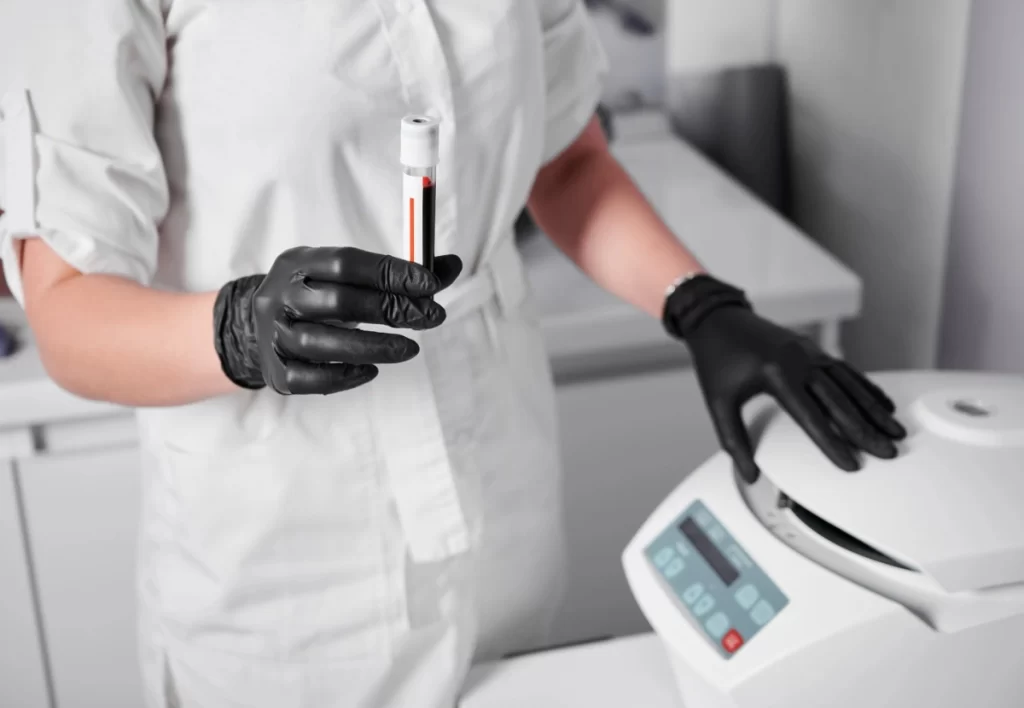Table of Contents
Introduction
Menorrhagia, or heavy menstrual bleeding, is a common gynecological issue that affects countless women worldwide. Although menstrual flow varies from person to person, excessively heavy or prolonged periods can significantly impact a woman’s quality of life, leading to physical discomfort, emotional distress, and even anemia due to excessive blood loss.
This article delves into the complexities of menorrhagia, exploring its causes, symptoms, and available treatment options. From underlying health conditions such as polycystic ovary syndrome, hypothyroidism, and cervical or ovarian cancer to hormonal imbalances and structural abnormalities of the reproductive system, we will examine the various factors that can contribute to heavy bleeding during periods. By understanding the root causes of menorrhagia, women can take proactive steps toward finding relief, whether through lifestyle modifications, hormonal therapy, iron supplements, or surgical interventions.
Understanding Menorrhagia
Heavy menstrual bleeding is defined as menstrual blood loss greater than 80mls per cycle or requiring more frequent than 2-hour changes of hygiene products 8. It can also be considered when a woman passes large blood clots, needs double sanitary protection, frequent changes of tampons and towels (meaning changes every 2 hours or less, or 12 sanitary items per period), and flooding through to clothes or bedding 5.
The global prevalence of heavy menstrual bleeding varies depending on how it is measured. In America, the prevalence was 38.9% 7, while in five European countries, it was reported to be 27.2% 5. In developing countries, the prevalence ranges from 8%-27% 8. Menorrhagia accounted for 57.4% of all menstrual disorders assessed among adolescents in Nigeria 9.
Symptoms related to a patient with menorrhagia can be more revealing than laboratory tests. A detailed patient history should include inquiries about the menstrual history, presence of pelvic pain, menses pattern from menarche, contraceptive use, presence of hirsutism, systemic illnesses, symptoms of thyroid dysfunction, excessive bruising or known bleeding disorders, current medications, and previous surgeries or treatment of menorrhagia 8.
Physical examination starts with a standard gynecological examination, including a speculum examination to examine the cervix and a bimanual examination to determine the uterus’s size, shape, and mobility and to check for abnormalities 8.
Diagnosis of heavy menstrual bleeding involves both subjective and objective measures. The pictorial blood assessment chart (PBAC) is a subjective method that consists of diagrams representing different soiled towels and tampons. Women count their used towels or tampons daily and divide them by level of soiling. A PBAC score of 150 points most accurately correlates with menstrual blood loss of 80 ml 29. Although not a quantitative measurement, the PBAC can reliably predict heavy menstrual bleeding 19.
Objective diagnostic tests may include blood tests to check for anemia and coagulation disorders, pelvic ultrasound to identify uterine abnormalities, and endometrial biopsy to rule out hyperplasia or cancer 8. Disorders of hemostasis should be suspected in women with a history of bleeding associated with surgery, dental extraction, childbirth, bruising, or heavy menstrual bleeding since menarche 1213.

Common Causes of Menorrhagia
Menorrhagia can be caused by a variety of factors, ranging from hormonal imbalances to structural abnormalities in the reproductive system. Understanding these underlying causes is crucial for effective diagnosis and treatment.
Hormonal Imbalances
Estrogen and progesterone are hormones that work together to regulate the lining of the uterus (endometrium) during the menstrual cycle. When there is an imbalance in these hormones, the uterus can become too thick, resulting in heavy bleeding 19. Conditions such as polycystic ovary syndrome (PCOS), obesity, insulin resistance, and thyroid problems can cause hormone imbalances that lead to menorrhagia 20.
If the ovaries do not release an egg during the menstrual cycle, the body does not produce enough progesterone. This leads to a hormone imbalance and may cause heavy bleeding 20.
Uterine Fibroids
Adenomyosis
Polycystic Ovary Syndrome (PCOS)
PCOS is a common endocrine disorder that affects approximately 6% of women in the reproductive age group 19. Women with PCOS have normal levels of estrogen, but low levels of progesterone. This constant mitogenic stimulation of the endometrium leads to endometrial hyperplasia and unscheduled bleeding 19.
Medications and Medical Conditions
Certain medications, such as anti-inflammatory drugs, hormonal medications, and anticoagulants, can contribute to heavy or prolonged bleeding 20. Additionally, medical conditions like liver or kidney disease may be associated with heavy menstrual bleeding 19 20.
Intrauterine devices (IUDs) can also cause menorrhagia as a side effect 20. In such cases, a healthcare professional can help determine an alternate form of birth control if necessary.
By understanding these common causes of menorrhagia, healthcare providers can better diagnose and treat this condition, helping women manage their symptoms and improve their quality of life.
Diagnosis and Tests
Diagnosing menorrhagia involves a comprehensive evaluation of a woman’s medical history, physical examination, and various diagnostic tests. A detailed patient history should include inquiries about the menstrual history, presence of pelvic pain, menses pattern from menarche, contraceptive use, presence of hirsutism, systemic illnesses, symptoms of thyroid dysfunction, excessive bruising or known bleeding disorders, current medications, and previous surgeries or treatment of menorrhagia 8.
Physical examination starts with a standard gynecological examination, including a speculum examination to examine the cervix and a bimanual examination to determine the uterus’s size, shape, and mobility and to check for abnormalities 8. Pap smear test results for cervical cytology should be current. If a suspicious vaginal or cervical lesion is present, it may warrant direct biopsy 34.
Blood Tests
Blood tests are an important part of the diagnostic workup for menorrhagia. A complete blood count (CBC) may be used to evaluate hemoglobin and hematocrit and determine the severity of anemia if present 34. Iron studies, including total iron-binding capacity (TIBC) and total iron, are used to assess iron stores 34.
Coagulation factors should be tested to rule out von Willebrand disease, idiopathic thrombocytopenic purpura (ITP), and factor II, V, VII, or IX deficiency, especially in the adolescent age group 34. Thyroid function tests and prolactin levels can rule out hyperthyroidism, hypothyroidism, and hyperprolactinemia, which can cause ovarian dysfunction leading to possible menorrhagia 34.
Liver function and/or renal function tests may be ordered when liver or kidney disease is suspected, as dysfunction of either organ can alter coagulation factors and/or the metabolism of hormones 34. Hormone assays, such as total testosterone and sex hormone-binding globulin or free testosterone, can assist in diagnosing biochemical hyperandrogenemia in those with suspected polycystic ovary syndrome (PCOS) 35.

Imaging Tests
Imaging tests are widely used in the work-up for women with heavy menstrual bleeding. Transvaginal ultrasonography (TVS) should be the first diagnostic test for identifying structural abnormalities 16. It can visualize subserosal and intramural fibroids and assess endometrial thickness. However, TVS cannot reliably distinguish between polyps, submucous fibroids, and adenomyosis, so further diagnostic tests such as saline infusion sonography (SIS) or hysteroscopy may be required if structural abnormalities are suspected 1920.
SIS or gel infusion sonography (GIS) is used to visualize intracavitary abnormalities and should only be used if TVS is inconclusive or if structural abnormalities are suspected 3237. These techniques involve instilling fluid into the endometrial cavity while performing a transvaginal ultrasound examination. A normal SIS or GIS excludes intracavitary pathology 23.
MRI is a second-line test used when the diagnosis from pelvic ultrasonography is unclear. It can diagnose adenomyosis or fibroids, although both can be detected with transvaginal ultrasonography 20. MRI should only be used if the result will affect treatment, such as in the case of fibroid mapping before minimally invasive myomectomy 3237.
Biopsy Procedures
Endometrial biopsy is used in women who are at risk for endometrial polyps, hyperplasia, or carcinoma, though other pathology may be found. It should be a first-line test in those with menorrhagia who are older than 45 years and those younger than 45 years with a history of exposure to unopposed estrogen, persistent menorrhagia, and/or failed medical management 23. Other high-risk patients who may need to be biopsied include those with hypertension, diabetes, chronic anovulation (e.g., PCOS), obesity, atypical glandular cells on Pap smear, new-onset menorrhagia, and those older than 70 years or any woman older than 35 years with new-onset irregular bleeding (especially if nulliparous) 34.
Endometrial biopsy findings are used to assess the stage and proliferation of the endometrial stroma and glands. Many studies have compared the results of endometrial biopsy and dilation and curettage (D&C), finding both tests to be approximately 98% accurate 37. However, routine endometrial biopsy and conventional imaging studies may miss small or laterally displaced lesions, so superior methods of assessment must be used in high-risk patients 34.
Hysteroscopy is another diagnostic procedure that can be done in the office but may require anesthesia if the patient has a low pain tolerance or adequate visualization is not obtainable 34. It provides direct visualization of the endometrial cavity after distending it with a medium, most typically normal saline. A primary advantage of hysteroscopy is the ability to detect and treat focal lesions, such as fibroids and polyps, immediately upon visual diagnosis 3738. A biopsy sample should be taken, regardless of the endometrial appearance, as the histologic diagnosis is missed in less than 2% of patients who undergo hysteroscopy with directed biopsy 3738.
Treatment Options for Menorrhagia
Heavy menstrual bleeding treatment depends on various factors, including the underlying cause, severity of symptoms, overall health, and personal preferences 39. Treatment options range from lifestyle modifications and medications to hormonal therapies and surgical interventions.
Lifestyle Changes
Making healthy lifestyle choices can help manage symptoms of menorrhagia. Regular exercise and maintaining a healthy BMI are recommended, as a high BMI increases the risk of ovulatory dysfunction and heavy or irregular menstrual loss 3 4 5. Staying hydrated by drinking plenty of water and eating iron-rich foods like leafy greens, meat, fish, and beans can prevent anemia caused by excessive blood loss 43 44 45.
Medications
Nonsteroidal anti-inflammatory drugs (NSAIDs) are often the first-line medical therapy for ovulatory menorrhagia, reducing menstrual blood flow by an average of 20-46% 41. NSAIDs work by inhibiting cyclooxygenase and decreasing the ratio of prostacyclin to thromboxane, which reduces prostaglandin levels 41 50. Tranexamic acid is another medication that helps reduce menstrual blood loss by preventing the breakdown of blood clots 50 51. It is taken orally during menstruation and can decrease blood loss by 30-55% 50 51.
Hormonal Treatments
Hormonal options for treating menorrhagia include combined oral contraceptive pills, progestin-only pills, injectable progestogens, and the levonorgestrel-releasing intrauterine device (LNG-IUS) 40 49. Combined oral contraceptives suppress pituitary gonadotropin release and ovulation, resulting in endometrial atrophy and reduced menstrual blood loss 42 49. The LNG-IUS slowly releases levonorgestrel, thinning the endometrium and decreasing menstrual blood flow by up to 97% after one year of use 46 49. Gonadotropin-releasing hormone (GnRH) agonists and antagonists induce a temporary hypogonadal state, leading to amenorrhea in up to 90% of users, but side effects limit their long-term use 26 27 43.
Surgical Options
Surgical management is often considered when medical therapy fails or for structural causes like fibroids 50. Procedures include:
- Dilation and curettage (D&C): Used for diagnostic purposes, providing short-term relief 50.
- Endometrial ablation: Destroys the endometrium using various techniques, resulting in lighter periods or amenorrhea 5354.
- Myomectomy: Surgical removal of uterine fibroids, preserving the uterus and fertility 57.
- Hysterectomy: Definitive treatment involving removal of the uterus and cervix, ending menstrual periods and the ability to conceive 1758.
Other procedural techniques like uterine artery embolization (UAE) can be used to treat menorrhagia associated with fibroids by blocking blood flow to the fibroids, causing them to shrink 50 [61].
The choice of treatment depends on individual circumstances, and a shared decision-making process between the patient and healthcare provider is essential to determine the most appropriate approach 50 59.

Conclusion
Menorrhagia is a prevalent gynecological issue that can significantly impact a woman’s quality of life. By understanding the various causes, from hormonal imbalances to structural abnormalities, women can take proactive steps in seeking appropriate diagnosis and treatment. A comprehensive evaluation, including a detailed patient history, physical examination, and diagnostic tests, is crucial in determining the underlying factors contributing to heavy menstrual bleeding.
Treatment options for menorrhagia are diverse, ranging from lifestyle modifications and medications to hormonal therapies and surgical interventions. The most suitable approach depends on the individual’s specific circumstances, taking into account the cause, severity of symptoms, overall health, and personal preferences. Through a shared decision-making process between the patient and healthcare provider, women can find relief from the discomfort and distress associated with heavy menstrual bleeding and improve their overall well-being.
FAQs
What primarily causes menorrhagia?
Menorrhagia is often caused by hormonal imbalances. Hormones such as estrogen and progesterone regulate the menstrual cycle, and any imbalance can result in heavy menstrual bleeding.
What are the warning signs of menorrhagia?
The red flags for menorrhagia include needing to change sanitary pads or tampons during the night, menstrual periods that extend beyond seven days, passing blood clots the size of a quarter, and experiencing a flow so heavy it restricts daily activities.
How does menorrhagia differ from general heavy menstrual bleeding?
Menorrhagia is a specific medical term used when a person loses more than 5 to 6 tablespoons (about 80 milliliters) of blood during their period, characterizing it as heavy or prolonged menstrual bleeding.
What is the most effective treatment for menorrhagia?
The most prescribed treatment for menorrhagia is progestin. Progestin is effective and safe, even in the presence of other medical conditions, and significantly reduces menstrual blood flow when used as a standalone treatment.
References
[1] – https://www.mayoclinic.org/diseases-conditions/menorrhagia/symptoms-causes/syc-20352829
[2] – https://my.clevelandclinic.org/health/diseases/17734-menorrhagia-heavy-menstrual-bleeding
[3] – https://www.hopkinsmedicine.org/health/conditions-and-diseases/menorrhagia
[4] – https://www.hopkinsmedicine.org/health/conditions-and-diseases/menorrhagia
[5] – https://www.mayoclinic.org/diseases-conditions/menorrhagia/symptoms-causes/syc-20352829
[6] – https://my.clevelandclinic.org/health/diseases/17734-menorrhagia-heavy-menstrual-bleeding
[7] – https://www.ncbi.nlm.nih.gov/books/NBK536910/
[8] – https://emedicine.medscape.com/article/255540-overview
[9] – https://www.ncbi.nlm.nih.gov/pmc/articles/PMC10388676/
[10] – https://www.mayoclinic.org/diseases-conditions/menorrhagia/diagnosis-treatment/drc-20352834
[11] – https://www.mayoclinic.org/diseases-conditions/menorrhagia/symptoms-causes/syc-20352829
[12] – https://my.clevelandclinic.org/health/diseases/17734-menorrhagia-heavy-menstrual-bleeding
[13] – https://www.hopkinsmedicine.org/health/conditions-and-diseases/menorrhagia
[14] – https://www.mayoclinic.org/diseases-conditions/menorrhagia/symptoms-causes/syc-20352829
[15] – https://www.ncbi.nlm.nih.gov/pmc/articles/PMC5779565/
[16] – https://www.mayoclinic.org/diseases-conditions/menorrhagia/symptoms-causes/syc-20352829
[17] – https://www.nj.gov/health/womenshealth/reproductive-health/periods-menstruation/heavy-periods/
[18] – https://www.baptisthealth.com/care-services/conditions-treatments/menorrhagia
[19] – https://www.ncbi.nlm.nih.gov/pmc/articles/PMC9580818/
[20] – https://www.everydayhealth.com/womens-health/uterine-fibroids-heavy-menstrual-bleeding/
[21] – https://www.fda.gov/news-events/press-announcements/fda-approves-new-option-treat-heavy-menstrual-bleeding-associated-fibroids-women
[22] – https://pubmed.ncbi.nlm.nih.gov/24408315/
[23] – https://www.hopkinsmedicine.org/health/conditions-and-diseases/adenomyosis
[24] – https://my.clevelandclinic.org/health/diseases/14167-adenomyosis
[25] – https://www.northsidegynaecology.com.au/what-are-periods-like-when-you-have-pcos/
[26] – https://www.ncbi.nlm.nih.gov/pmc/articles/PMC3849664/
[27] – https://journals.sagepub.com/doi/full/10.2217/WHE.09.20
[28] – https://www.yourperiod.ca/abnormal-pain-and-menstrual-bleeding/heavy-menstrual-bleeding/medications-that-cause-heavy-menstrual-bleeding/
[29] – https://my.clevelandclinic.org/health/diseases/17734-menorrhagia-heavy-menstrual-bleeding
[30] – https://www.uptodate.com/contents/heavy-or-prolonged-menstrual-bleeding-menorrhagia-beyond-the-basics/print
[31] – https://emedicine.medscape.com/article/255540-clinical
[32] – https://www.ncbi.nlm.nih.gov/pmc/articles/PMC5779565/
[33] – https://www.mayoclinic.org/diseases-conditions/menorrhagia/diagnosis-treatment/drc-20352834
[34] – https://emedicine.medscape.com/article/255540-workup
[35] – https://www.mayoclinic.org/diseases-conditions/menorrhagia/diagnosis-treatment/drc-20352834
[36] – https://www.news-medical.net/health/Diagnosis-of-Menorrhagia.aspx
[37] – https://www.ncbi.nlm.nih.gov/pmc/articles/PMC5779565/
[38] – https://emedicine.medscape.com/article/255540-workup
[39] – https://www.mayoclinic.org/diseases-conditions/menorrhagia/diagnosis-treatment/drc-20352834
[40] – https://my.clevelandclinic.org/health/diagnostics/15676-endometrial-biopsy
[41] – https://www.hopkinsmedicine.org/health/treatment-tests-and-therapies/endometrial-biopsy
[42] – https://www.healthdirect.gov.au/surgery/endometrial-biopsy
[43] – https://www.centerforwomen.com/blog/menorrhagia-friendly-diet-changes-to-make-today
[44] – https://www.medicalnewstoday.com/articles/325965
[45] – https://www.healthline.com/health/how-to-stop-heavy-periods
[46] – https://www.mayoclinic.org/diseases-conditions/menorrhagia/diagnosis-treatment/drc-20352834
[47] – https://www.thewomens.org.au/health-information/periods/heavy-periods/treating-heavy-bleeding-with-medication
[48] – https://medlineplus.gov/druginfo/meds/a612021.html
[49] – https://www.ncbi.nlm.nih.gov/pmc/articles/PMC4728737/
[50] – https://emedicine.medscape.com/article/255540-treatment
[51] – https://www.mayoclinic.org/diseases-conditions/menorrhagia/diagnosis-treatment/drc-20352834
[52] – https://www.mayoclinic.org/diseases-conditions/menorrhagia/diagnosis-treatment/drc-20352834
[53] – https://www.ncbi.nlm.nih.gov/books/NBK435697/
[54] – https://emedicine.medscape.com/article/255540-treatment
[55] – https://www.mayoclinic.org/diseases-conditions/menorrhagia/diagnosis-treatment/drc-20352834
[56] – https://my.clevelandclinic.org/health/diseases/17734-menorrhagia-heavy-menstrual-bleeding
[57] – https://www.hopkinsmedicine.org/health/conditions-and-diseases/menorrhagia
[58] – https://www.ncbi.nlm.nih.gov/pmc/articles/PMC4728737/
[59] – https://www.mayoclinic.org/diseases-conditions/menorrhagia/diagnosis-treatment/drc-20352834
[60] – https://www.ncbi.nlm.nih.gov/books/NBK279293/






